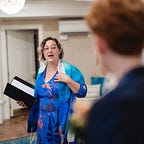The Queer Freedom of Passover
Passover is my favorite holiday. It’s my favorite because it transmits a message of radical empathy intellectually, emotionally, spiritually, sensually, and gastronomically.
We dip the freshness of spring and new growth (often represented by parsley in Ashkenazi seders) in the salty tears of our ancestors (represented by salted water). Charoset, a sticky and sweet mixture of fruits and nuts that varies according to region and family tradition, reminds us of the mortar that bound the bricks of the structures the enslaved built for Pharaoh, and it binds us, today, to all who are oppressed around the world.
At seder, we do things differently, queerly, you might say. We do not only to keep the attention of the restless children at our late-night dinner table, but also to pull the adults out of our complacence. Reclining, dipping, tasting symbolic foods, and the reenacted tales of Biblical and Rabbinic ancestors are all designed to open our hearts to how injustice happens. Our props and ritual items, our “plague headbands” that playfully present what might otherwise be the unbearable truth of the cost of our freedom: all of them help us to build radical empathy.
In every generation, a person is obligated to see themselves as though they had made exodus from Egypt.
